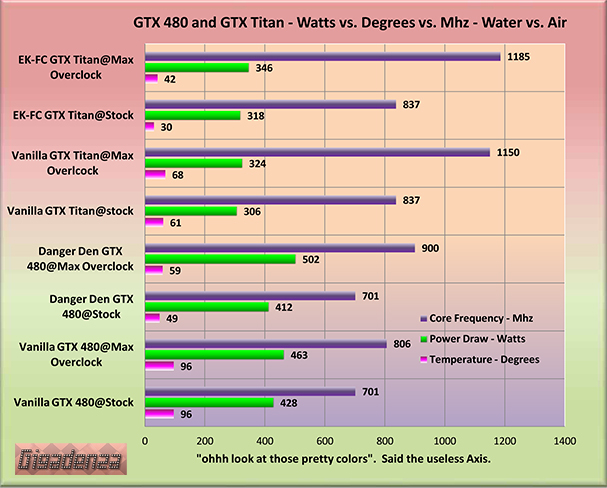H20+TDP=Pointless or Productive…?
Degrees Vs. Watts Vs. Mhz
A brief harvest of HTML tells us the GTX Titan’s premium water cooling accoutrements can maintain load temperatures as low as 42 degrees. Though we cannot assume this tempting figure would match that of our subject, whose tests were conducted under different conditions, it nevertheless sounds impressive. The question is, what return in megahertz would such a drop translate to and how long before wattage rose sufficiently to once again make temperature an irrelevance?

These figures are “mean averages” based on statistics collated from various reviews and show the performance gains possible for the Titan and the 480 when each is armed with lordly liquid laden defences.
The Danger Den water block used on the 480 is a commendably customised nickel plated creation, skilfully crafted by the Oregon based company to envelop the most thermally volatile components, including the memory and voltage regulators, besides the feverish Fermi. The block itself is engineered in a single part with a mesmerically mirrored finish and lusciously lapped base. Raised ridges on the underside guarantee optimal contact with the RAM.
After removing the original cooling assembly, and the routine “clean and paste”…
Hmm. How much? A grain of rice, half a pea, a sprout, a plum, a lime? Should I spread or should I squish?
….it is attached to the card via four screws and rubber wasters. The Vregs populating the card’s top-front are left exposed, unlike those on EVGA’s copper bottomed Fermi Eulogy (The Hydro FTW Edition) which uses proprietary aquatics co-developed by themselves and Swiftech. In the interests of assessing the most beneficial solutions, it would have been ideal to include this model in our investigation, I searched like a Mythbuster and sadly, the internet imparted insufficient data.
Turning our attention to the Titan’s honoured hydrator, the EK-FC is developed, manufactured and distributed by EKWB, a small, highly specialised firm based in Slovenia. When compared to the Danger Den, save for a squarer stature and a peppering of perspex, the pair are a submersible sister act. The dual part design consists of a sturdy retention plate mounted on the card’s rear, and an electrolytic copper block, also nickel plated, covering the RAM, GPU and healthy majority of VRMs. It’s optional backplate may foil the Kepler’s feverish fear of farenheit by a dwindling degree, but not enough to eschew any crucial calculations.
In the chart we have two groups of results with four tests for each and three variables per test. The axis labels on left identify our subjects and the tests conducted.
Power draw, temperature, and core frequencies for the ready salted, air-cooled cards in their stock and super charged states and the same set of values for our submerged participants when tweaked to their respective extremes. Results for the water cooled cards in their default state are also included for reference.
Divulging a detailed analysis would be as pointless as a broken pencil in the hands of a humble hobbyist who has compiled a delicious quad layer charter pounder to an avoid any arduous analysis. Thus, I shall let these bounty-ful bars flower fruitful facts unassisted. Just be mindful that all thermal and power measurements were taken when both GPUs were sailing at full steam and we are not concerned about their comparative speeds, but the extent to which each flourished below its flow of fancy fluid.




